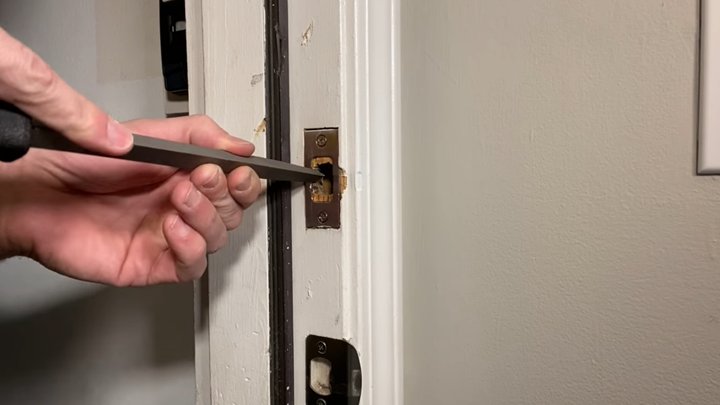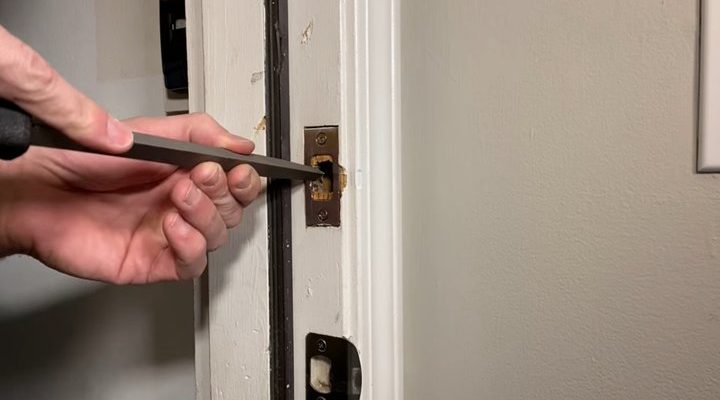
Double-cylinder deadbolts (the kind that use a key on both sides) are popular for their extra security. Still, when the keyhole and the lock mechanism aren’t lined up just right, things get tricky fast. Sometimes it feels like a stubborn vending machine: everything looks fine, but nothing works until you do things exactly right. And if you own a remote-controlled deadbolt or a smart deadbolt from brands like August or Yale, you might be scratching your head at terms like “code,” “sync,” or “pair” when all you really want is for your key to work smoothly. Let’s break down how to get everything back in sync—no locksmith required.
How a Double-Cylinder Deadbolt Works and Why Alignment Matters
Let me explain what’s happening inside your door. A double-cylinder deadbolt has a locking cylinder on both the inside and outside. That means you use a key on both sides—extra safe, especially for doors with glass windows. There’s a small metal rod, called a tailpiece or *cam*, that connects both cylinders through the deadbolt mechanism. When you turn the key, this piece moves to slide the bolt in or out.
Here’s the thing: every turn of the key relies on all the pieces being lined up just right. If the lock body, the keyhole, or the bolt are even a little bit out of place, your key might stick, won’t turn, or just won’t go in at all. It’s a bit like a zipper that’s misaligned by one tooth—nothing moves until you fix it.
Most often, misalignment happens because of these issues:
- Normal wear and tear on the door or frame
- Improper installation of the lock
- Temperature or humidity causing wood to swell or shrink
- Screws loosening over time
On top of that, if you’ve got a smart deadbolt or a remote-controlled lock that requires codes for syncing or resetting, those digital parts need to be calibrated too—or mechanical misalignment can “confuse” the electronics, making things worse.
Common Signs Your Double-Cylinder Deadbolt Is Misaligned With the Keyhole
When a double-cylinder deadbolt is misaligned, the signs aren’t always obvious at first. Many people think the problem is with the key or the lock itself, but it’s often about the alignment. Here’s what you might notice:
- The key won’t fully insert: You push, but the key stops before it’s all the way in.
- The key is hard to turn: You have to jiggle or force it, and it feels “stuck.”
- The deadbolt feels stiff: Locking or unlocking takes real effort, or the bolt barely moves.
- Your smart lock won’t respond: If you’re using a remote, the lock doesn’t sync or pair.
Honestly, it can be tempting to blame a worn-out key or a dead battery in your remote, but misalignment is one of the most common culprits. If left unchecked, it can even damage the lock or cause your key to snap off inside.
First Steps: Quick Checks Before Taking the Lock Apart
Before you grab your screwdriver or call a locksmith, start with these easy steps. You might solve the problem faster than you think.
- Check the key: Try a spare key if you have one. Sometimes a worn-down key tip causes problems that look like alignment issues.
- Look at the door: Close it slowly and see if the bolt lines up with the strike plate (the metal piece on the door frame). If the bolt hits the plate or doesn’t slide in smoothly, alignment is likely the problem.
- Inspect the screws: Gently tighten the mounting screws on both sides of the lock and the strike plate. Loose screws can shift the lock just enough to cause trouble.
- Cycling the lock: Use the key to turn the deadbolt several times. Listen and feel for resistance—a sign something’s out of place.
If you use a remote-controlled or digital deadbolt, like an August or Yale model, make sure the “pair” or “sync” codes are correct and check the battery. Sometimes, a low battery can mimic mechanical alignment problems by not providing enough power to move the bolt fully.
Step-by-Step: How to Realign a Misaligned Double-Cylinder Deadbolt
If the quick checks didn’t do the trick, don’t worry. Realigning a double-cylinder deadbolt is usually a beginner-friendly fix. Here’s how to tackle it step by step:
1. Remove the lock’s faceplate
- Use a screwdriver to take off the screws from the inside and outside faceplates.
- Carefully pull the two halves of the deadbolt apart, keeping track of all parts.
2. Inspect the cylinder alignment
- Look at the tailpiece running through the deadbolt. It should be straight and centered in the housing.
- If it’s bent or off-center, gently straighten it by hand or with pliers.
3. Check the bolt and strike plate
- With the deadbolt open, try sliding it in and out. It should move smoothly. If not, adjust the strike plate on the door frame by loosening, shifting, and re-tightening its screws until the bolt lines up perfectly.
4. Reassemble and test
- Put the lock back together but don’t fully tighten the screws yet. Insert your key and test the action on both sides. If it moves smoothly, finish tightening the screws.
Tip: For smart or remote deadbolts, perform a *reset* or re-sync as described in your lock’s manual after reassembly. This step ensures the digital “code” matches the physical position of the bolt.
“When in doubt, go slow. Forcing parts back together can actually make alignment worse or strip the screws, so patience always pays off.”
What If the Door Frame Is the Real Problem?
Sometimes the deadbolt itself is fine, but the door or frame has shifted. Wood expands in summer and contracts in winter, and even a tiny change can knock your lock out of sync. Here’s how to spot and fix frame issues:
- Check for visible gaps: Look at the space between the door and frame. It should be even all the way around. Big gaps or tight spots signal a problem.
- Test the door swing: Does the door rub at the top, bottom, or latch side? Swollen wood can push the deadbolt out of line.
To fix minor frame misalignment:
- Adjust the strike plate: Sometimes, loosening the plate and shifting it a few millimeters is all it takes to let the bolt slide in smoothly. If you see old screw holes, use wood filler or toothpicks to keep the screws tight.
- Sand problem areas: If the door sticks, sand down tight spots for a better fit. Focus on the areas where the bolt gets “caught.”
- For major shifts: If the whole door has drooped (say, after years of use or weather changes), you may need to adjust the door hinges. Tighten all hinge screws and, if needed, use longer screws to pull the door tight to the frame.
Taking these steps keeps both your mechanical and digital deadbolts “in sync” with their surroundings—and saves wear and tear in the long run.
When to Reset or Sync a Smart Deadbolt
You might be wondering, “What if I have a smart deadbolt or a remote lock, like an August, Schlage, or Yale model?” Good question. Here’s where things get interesting: many digital locks use sensors or a code to “learn” the position of the bolt. If your lock’s misalignment is fixed, but the smart features still won’t work, you may need to reset or sync the lock.
- Follow the manual: Each brand handles this process a little differently. Usually, it involves holding a reset button, entering a code, or pairing your remote again.
- Make sure the battery is fresh: Low battery voltage can cause all sorts of odd syncing issues. Swap in new batteries before you start.
- Calibrate the bolt: Some smart locks require you to manually lock and unlock them after a reset, so the internal motor “learns” what fully open and fully closed feel like.
If you find yourself lost in menus or code errors, don’t panic. Most modern locks offer a factory reset option that rewinds everything to square one. That lets you re-pair your device and start fresh—especially helpful if your lock has been out of sync for a while.
Preventing Future Misalignment: Maintenance Tips
Once your double-cylinder deadbolt is working smoothly, a little routine care keeps it that way. Here’s what I recommend for both classic mechanical and smart deadbolts:
- Tighten screws every few months: Doors get slammed, and vibrations can work screws loose.
- Lubricate the cylinder: Use a graphite-based lock lubricant once or twice a year. Skip the WD-40 or oil—those just attract dust.
- Check the door for swelling: Especially after big weather changes, eyeball the door’s fit and the bolt’s movement.
- Update firmware (for smart locks): If your lock connects to Wi-Fi or Bluetooth, keep the software up to date. This keeps things in sync and can fix weird bugs.
- Keep spare keys handy: If a key stops working, replace it before forcing or it breaks off in the lock.
These steps aren’t just about preventing future lockouts; they help your deadbolt—whether it’s a traditional Schlage or a fancier Yale remote lock—last years longer.
Should You Replace or Upgrade Your Double-Cylinder Deadbolt?
If you’ve realigned everything and your deadbolt still acts up, you might be dealing with worn-out parts or a lock that’s just ready for retirement. Here’s how to decide if it’s time to replace or upgrade:
- Keep the same model: If you like your current lock’s feel, an exact replacement is the easiest switch. Most modern Schlage and Kwikset cylinders can be swapped with minimal fuss.
- Consider a smart upgrade: If you want remote access, codes, or pairing features, a smart deadbolt is worth a look. Many work with existing deadbolt holes, so installation is simple.
- Call a pro: If the door or frame has severe damage or the lock won’t align no matter what, a locksmith or handyman can save you serious time and frustration.
Just remember: security is the main goal. Don’t put up with a stubborn lock for too long—an easy-to-use, well-aligned deadbolt keeps your home safe and your keys happy.
Wrapping Up: A Smooth-Working Deadbolt Brings Peace of Mind
A misaligned double-cylinder deadbolt is annoying, but it’s usually easy to fix as long as you take things slow and pay attention to the details. Whether you’re tweaking a classic Schlage or syncing up a Yale smart lock, the main thing is to make sure everything—mechanical parts, digital codes, and even the door itself—works together smoothly. With a few basic tools, a little patience, and some simple troubleshooting, you can bring your lock back into perfect alignment. You’ll not only avoid future lockouts but also protect your home, your sanity, and your keychain—one turn at a time.
